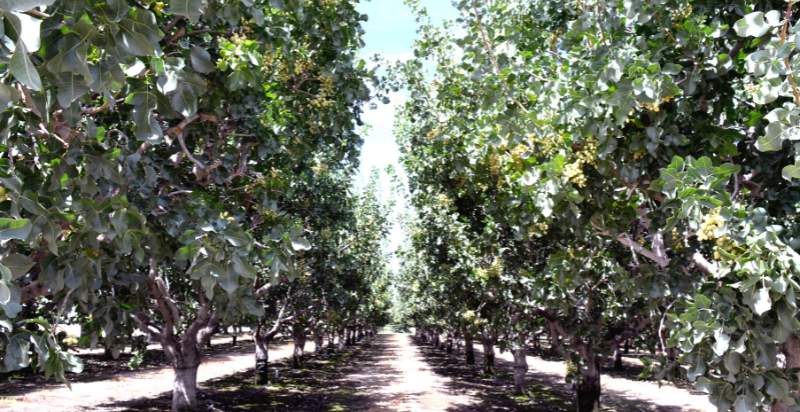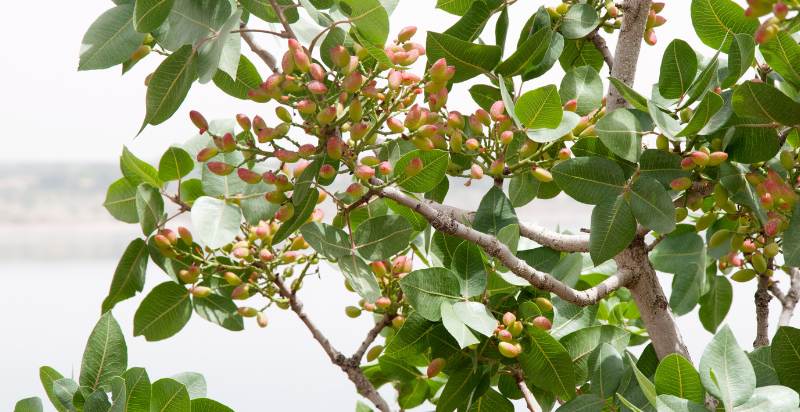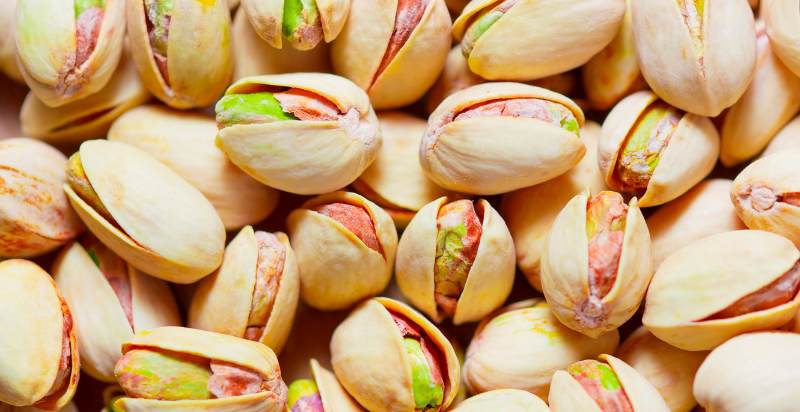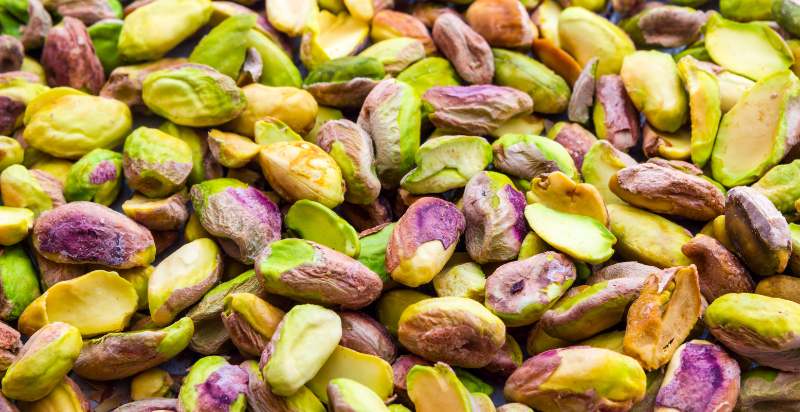Pistachio is a small, nutritious nut that has been used for centuries in Middle Eastern cuisine and traditions. It is a versatile ingredient used in sweet and savory dishes, making it an essential part of many cultures. The pistachio has a unique flavor and is rich in nutrients such as fiber, protein, vitamins A and E, iron, zinc, and magnesium. Here’s everything you need to know about Pistachio, how they can benefit your health, and how to plant and grow them.
What is Pistachio?
Pistachio is a type of nut that belongs to the Anacardiaceae family, which includes cashews and mangoes. It is in an edible seed that grows inside a hard shell. The ripe fruit is yellow-green with reddish-brown spots, while the inner kernel is pale green in color. Pistachio nuts have a creamy texture and mild, slightly sweet flavor.
History and Origin of Pistachio
The pistachio, also known as the green nut, has a long and rich history that dates back over 6 millennia. The earliest recorded evidence of pistachio consumption comes from the Mesopotamian region in Iran, where archeologists have discovered shells from the edible nuts dating back to 6750 BC. In ancient times, pistachios were considered a delicacy and often served at elaborate banquets. Many cultures highly valued Pistachios and often used them as currency or even given as gifts to kings.
Pistachios migrated along with traders and conquerors throughout the Middle East and eventually made their way into Europe in 1000 BC. From there they spread further around the world to countries like Turkey, Syria, Greece, and Italy.
In more recent history, pistachios were brought to California in the late 19th century. Today, this is the largest producer of pistachios in the world, accounting for over 90% of global production. Pistachio trees are also widely grown throughout Asia, particularly in countries like Iran, Pakistan, and China.
While pistachios have a long and varied history, their many culinary uses continue to make them popular today. They are commonly used as an ingredient or garnish for salads and other dishes or enjoyed as a healthy snack. In addition to being tasty, they offer several health benefits due to their high nutrient content, including vitamins A and E and antioxidants and fiber. As a result, pistachios are becoming increasingly popular in health foods like energy bars and protein powders.
Regardless of their many uses, one thing is for sure – the pistachio has been around for centuries and will continue to be enjoyed by people worldwide for years to come.
Types of Pistachio:
Pistachios come in a variety of types depending on their origin. Some of the most common types include:
- Iranian Pistachio: These are the largest pistachios and have a dark green to light brown color. They are usually used for baking, snacking, or making desserts like baklava and halvah.
- American Pistachio: These are known for their bright green color and sweetness. They are generally smaller than other pistachios, making them perfect for snacking, topping salads, or chopping up into sauces or salad dressings.
- Turkish Pistachio: These have a rich flavor that is both sweet and salty at the same time. This pistachio is often used as a garnish or chopped and added to salads.
- Greek Pistachio: These are smaller than other types but have an intense flavor that makes them popular for baking and desserts.
- Indian Pistachio: These are the sweetest pistachios, with a creamy texture and subtle nutty flavor. They are perfect for snacking on their own or adding to recipes.
- Afghan Pistachio: This type has a slightly sharp taste, making it ideal for savory dishes like curries and stews.
No matter which type you choose, pistachios offer a wide variety of uses in both sweet and savory recipes!
Nutritional Value of Pistachio:
Pistachios are an excellent source of nutrition, packed with various vitamins and minerals that can benefit your health. A one-ounce serving (about 49 nuts) contains 160 calories and 6 grams of protein, making it an excellent snack choice for those looking to increase their protein intake. Pistachios are also a good source of healthy fats, containing 13 grams per ounce, mostly monounsaturated fatty acids like oleic acid.
In addition to this impressive balance of macronutrients, pistachios are also rich in many essential nutrients, including copper, thiamin, vitamin B6, phosphorus, magnesium, and manganese. Copper helps support healthy connective tissue and skin, while thiamin helps provide energy throughout the body. Vitamin B6 contributes to brain development, and phosphorus is essential for strong bones and teeth. Magnesium helps maintain normal blood pressure levels, while manganese plays a role in metabolism and cellular production.
Finally, pistachios are an excellent source of dietary fiber, providing 3 grams per one-ounce serving. Fiber is important for digestion and is linked to reduced cholesterol levels and improved heart health. These nutritional benefits make pistachio nuts a healthy snack choice that can fit into almost any diet plan!
Health Benefits of Pistachio:
Pistachios are a powerhouse of essential nutrients. They’re not just delicious; they offer numerous health benefits, too. The variety of vitamins and minerals that pistachios provide can help promote good health in several ways.
For starters, pistachios pack lots of protein, fiber, potassium, and healthy fats (in the form of mono- and polyunsaturated fatty acids). Eating more pistachios may lower your risk for heart disease by promoting healthy cholesterol levels in the body. Pistachios contain magnesium, which helps with calcium absorption, providing protection from osteoporosis and helping strengthen bones overall. They are also full of antioxidants, like lutein and zeaxanthin, that help to protect the eyes from macular degeneration.
Pistachios are also a great source of Vitamin B6, which is important for maintaining healthy skin and metabolic balance and aiding in forming red blood cells. Eating pistachios can help you to feel fuller longer due to the protein and fiber content that helps promote satiety after meals. Plus, studies have shown that eating pistachios regularly can improve digestion and aid in weight management.
Overall, adding pistachios to your diet can be beneficial for promoting health as part of an overall balanced diet plan. Enjoying these tasty little nuts in moderation can help ensure you get all their nutritional benefits without overdoing it on calories or fat.
Uses of Pistachio:
Pistachios are versatile nuts and can be used in many different ways. They can be eaten raw, added to salads, roasted or salted as a snack, or even ground into flour for baking. Pistachios are also a great source of essential vitamins and minerals such as magnesium, phosphorus, zinc, and vitamin E. Pistachio oil is used in cooking and can add flavor to dishes such as stir-fries and curries.
The shells of the nuts can also be used to make decorative crafts like jewelry or wreaths. Furthermore, pistachio butter is an excellent alternative for those allergic to peanuts. Finally, pistachio milk has become increasingly popular among health-conscious individuals due to its high calcium content and delicious nutty flavor. No matter how you use them, pistachios will surely add a unique and tasty flare to your dishes.
How to Plant Pistachio?
Pistachio tree is beautiful, hardy, and relatively easy to grow – making them a great choice for anyone looking to add something different to their garden. Although they can be a bit finicky regarding watering and soil requirements, once you have them established, they are relatively low-maintenance. This article will cover everything you need to know about planting pistachio tree, including the best time to do it, what kind of soil they prefer, and how to water them properly. You will be ready to add these lovely trees to your landscape by the end!
When is the best time to plant pistachio tree?
The best time of year to plant pistachio tree is in late winter or early spring when the ground is still cold, but there is no threat of frost. The warmer temperatures will help the trees become established faster and give them plenty of time to establish healthy roots before the summer heat.
What kind of soil do pistachio Tree prefer?
Pistachios prefer well-draining soils with a slightly acidic pH between 6.0 and 8.0. They are not overly picky about soil type as long as it meets these requirements – sandy loam, clay loam, and silt loam all work well for planting pistachio trees. If drainage is an issue, adding organic matter, such as compost, can help improve it.
How should Pistachio tree be watered?
Pistachio tree need to be watered deeply about once per week if there is no rain. When watering, it’s important to soak the soil around the tree until it’s completely saturated – this will encourage strong root growth and prevent shallow roots from forming. Watering in the morning gives the tree time to absorb water before the hot afternoon sun sets in.
A step-by-step guide to plant pistachio :
- Select a location in your garden that has good drainage and full sun exposure, ideally with no trees or buildings blocking out the sun
- Dig a hole twice as wide and just as deep as the root ball of your pistachio tree
- Place the tree in the center of the hole, so it is level with the surrounding soil
- Backfill the dirt around the roots, gently packing down to remove any air pockets
- Water deeply until saturated – make sure to water every week or two again during dry conditions
- Mulch heavily around the new tree to keep moisture in and weeds out
- Monitor for pests or diseases and treat them if necessary
- Prune the tree regularly to promote healthy growth
- Enjoy your pistachio tree and the delicious nuts it will produce!
Congratulations, you now know everything you need to plant a pistachio tree! All that is left is to find the perfect spot in your garden and get planting. With a little care and attention, you’ll soon have a beautiful and productive addition to your landscape. Good luck!
How to Care for and Grow Pistachios?
Pistachios are a type of nut distinct for their greenish-brown color, slightly sweet and salty flavor, and crunchy texture. Growing your pistachios can be a rewarding experience, but it does require some extra care and attention. Here are some useful tips on how to care for and grow your pistachios:
- Select an ideal location: Pistachio trees need direct sunlight so choose a spot with as much full sun exposure as possible. The soil should also be well-draining yet still be able to retain moisture during dry periods.
- Plant at the right time: Depending on where you live, the optimal time to plant a pistachio tree is during the fall or early spring. Planting in late summer can be risky as extreme heat and drought conditions are more common.
- Care for your tree: As with any tree, keeping the area around your pistachio tree well-weeded and watered regularly during the growing season is important. Pruning back branches will encourage healthy growth and ensure that your tree doesn’t become too top-heavy or overcrowded.
- Harvesting: Pistachios are ready for harvesting about three years after planting once the nuts have dropped from their husks naturally. If you plan to wait until the nuts drop, make sure you wait until they turn from green to brown before picking them up.
Growing your own pistachios can be a rewarding experience and once you have mastered the necessary steps, it can also be a cost-effective way to enjoy this delicious snack. With the right care and attention, you’ll soon find yourself harvesting your home-grown nuts!
**Bonus Tip:** If you live in an area that experiences cold winters, consider wrapping young trees with burlap fabric or plastic tree wrap to provide extra insulation in the colder months. This will help protect your trees from freezing temperatures.

Preventions from Pests and Diseases of Pistachios:
Prevention from pests and diseases of Pistachios is essential for a healthy crop. It starts with selecting disease-resistant varieties adapted to the local climate and soil conditions in order to reduce losses due to pests and pathogens. Crop rotation is also important since it reduces the buildup of disease-causing organisms in the soil. Additionally, using organic mulches around plants, such as straw or hay, can help reduce pest populations and conserve moisture.
Pistachio trees should be regularly inspected for signs of infestation or infection. Prompt removal of infected trees or branches helps reduce the spread within the same crop or to adjacent crops. Appropriate pesticides can also help prevent outbreaks if used correctly according to label instructions. Properly timed irrigation and fertilization can also help prevent outbreaks of pests and diseases.
Finally, crop sanitation is important to reduce the spread of disease. This includes removing diseased plant material, such as fruit or nuts, from the tree before harvest season. Also, properly cleaning and storing tools used in pruning and harvesting can help minimize the transmission of pests or disease organisms between trees.
By following these prevention strategies for pests and diseases, producers can ensure a healthy crop with higher yearly yields. Prevention is always better than dealing with an outbreak that could cause serious damage to crops. Taking proper measures will pay off in the long run in terms of healthier plants and more profitable harvests!

How to Harvest Pistachios?
Harvesting pistachios is a simple process that can be done in just a few steps.
- Start by checking the color of the shell – it should be mostly brown, with some green hues. If it’s too green, the nuts aren’t ripe yet and you should wait a bit longer before harvesting them.
- Once you’ve determined that the nuts are ripe, gently shake the tree and branches to loosen the nuts from their shells. The more mature nuts will easily fall off while those that are not ready yet may require more gentle shaking or hand-picking at this stage.
- Collect all the fallen nuts into your harvest basket or container as soon as possible to avoid damage or contamination.
- Once you’ve collected all the nuts, sort them based on size and color. Discard any that appear damaged or have visible signs of mold, and discard those with green shells, as they are not ready for harvest yet.
- Spread out the harvested pistachios in an even layer onto a tarp or sheet and let them dry under direct sunlight for several days until their shells turn browner in hue and become brittle.
- When drying your pistachios, store them in an airtight container away from heat, light, or moisture to preserve their freshness and crunchy texture for as long as possible.

How to Store Homegrown Pistachios?
Storing homegrown pistachios is easy and can help them last longer. The key to successful storage is keeping the nuts dry, cool, and out of direct sunlight. Here are some tips for storing homegrown pistachios:
- Keep them in an airtight container such as a glass jar or plastic bag. This will prevent moisture from entering the container and spoiling the nuts.
- Place the container in a cool, dark place such as a cupboard or pantry away from heat sources like radiators or ovens. If you don’t have any space inside your home, try placing the container in an insulated box with plenty of packing material to keep it cool outside.
- If you need to store the pistachios for an extended period, consider freezing them. This will help preserve their freshness and prevent the nuts from going rancid.
- Check your stored pistachios periodically to ensure they are still dry and free of mold or rot. Discard any that have gone bad and replace them with a new batch as needed.
With proper storage, homegrown pistachios can last several months or even up to a year if frozen properly! Enjoy your delicious snacks without worrying about spoilage by following these simple tips for keeping your homegrown nuts fresh and tasty!

How to Use Pistachio in your day-to-day life?
Pistachios can be used in various ways to make your day-to-day life easier, tastier, and more nutritious. Here are some ideas on how to incorporate pistachios into your meals and snacks:
- Add a few shelled pistachios to salads, oatmeal, cereal, or yogurt for an extra crunchy texture.
- Sprinkle chopped or crushed pistachios over pasta, stir fries, and other savory dishes.
- Make an energizing trail mix with nuts, seeds, and dried fruit. Include some shelled pistachios for added flavor.
- Bake muffins, cakes, or cookies with chopped or crushed pistachios stirred in the batter.
- Toast pistachio nuts in a pan over low heat to bring out their nutty flavor. Sprinkle them over hot or cold dishes.
- Make your pistachio butter by grinding up toasted pistachios until they become creamy and spreadable.
- Use ground or finely chopped pistachios as a coating for fish, chicken, tofu, or vegetables before baking or frying.
- Try adding them to smoothies for extra protein and healthy fats.
Adding Pistachios to your diet will give you all the amazing health benefits this little nut offers! Enjoy! 🙂

Potential Risks from Pistachio in your day-to-day life:
Despite the numerous health benefits associated with pistachios, there are potential risks. Eating too many of these nuts can lead to weight gain and related health concerns, including heart disease, stroke, hypertension, and diabetes.
Additionally, consuming large amounts of salted pistachios can cause water retention and bloat due to their high sodium content. People who have allergies to other tree nuts may also experience an adverse reaction when eating pistachios. Other possible side effects include digestive issues such as abdominal pain, diarrhea, headaches, rashes, and hives.
If you experience these symptoms after eating pistachios, seek medical attention immediately. Finally, pregnant women should limit their intake of pistachios due to potential mercury contamination. Therefore, practicing moderation when consuming pistachios is important, and always be aware of any potential allergies or sensitivities.
Conclusion:
Pistachios are versatile and delicious nuts that can be used in various ways by incorporating the numerous health benefits of pistachios, such as improved digestion and heart health, into your diet.
However, it is important to keep in mind potential risks when consuming large amounts of pistachios such as weight gain or allergies. Always practice moderation and be aware of any sensitivities you may have before adding them to your meals and snacks! Additionally, proper storage can help extend their shelf life, so they stay fresh for longer! Enjoy your homegrown nuts!
- Everything You Wanted to Know About Red Tamarillos - June 2, 2025
- A Guide to Tulips: Everything You Need to Know & More… - June 2, 2025
- Guanabana: Description, Flavor, Benefits, And Uses - May 27, 2025

3 thoughts on “What is Pistachio? How to Plant, Grow, and Harvest Pistachios ”
Comments are closed.